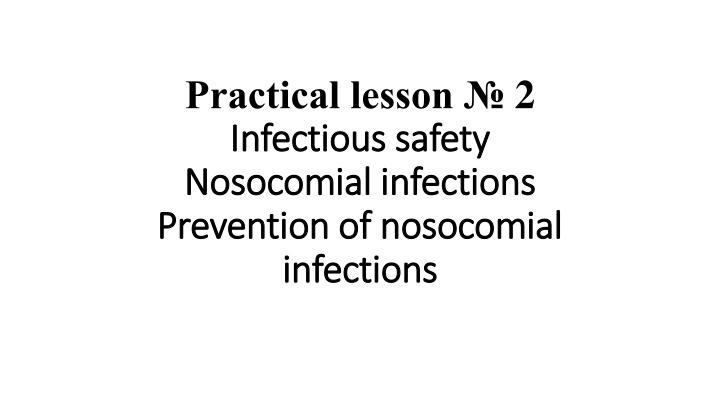
Nosocomial Infections and Prevention Strategies
Learn about nosocomial infections, including their classification as endogenous or exogenous, and the importance of preventing these hospital-acquired infections through proper protocols and hygiene practices. Discover the components of the chain of infection and the impact of infectious agents on susceptible hosts. Stay informed to promote a safer healthcare environment.
Download Presentation

Please find below an Image/Link to download the presentation.
The content on the website is provided AS IS for your information and personal use only. It may not be sold, licensed, or shared on other websites without obtaining consent from the author. If you encounter any issues during the download, it is possible that the publisher has removed the file from their server.
You are allowed to download the files provided on this website for personal or commercial use, subject to the condition that they are used lawfully. All files are the property of their respective owners.
The content on the website is provided AS IS for your information and personal use only. It may not be sold, licensed, or shared on other websites without obtaining consent from the author.
E N D
Presentation Transcript
Practical lesson 2 Infectious safety Infectious safety Nosocomial infections Nosocomial infections Prevention of nosocomial Prevention of nosocomial infections infections
Infection Infection is a biological phenomenon characterized by the interaction of a pathogenic microorganism with a macroorganism (human). Infectious process Infectious process - a complex of adaptive reactions of the organism in response to the introduction and proliferation of the pathogen. (Reactions aimed at restoration of homeostasis and disturbed biological equilibrium with the environment). Microorganism that can cause infectious disease is called a pathogen. Properties of pathogen: Invasiveness - the ability of the pathogen to penetrate through the skin and mucous membranes into the internal environment of a macroorganism. Toxigenicity the ability of microbes to produce toxins.
List the Components of the chain of infection. Main Components of the chain of infection (simple version). 1) Infectious agent (pathogen) 2) Route of transmission 3) Susceptible host.
Nosocomial infections Nosocomial infections Nosocomial infection (hospital) - is any clinical microbial disease, affecting the patient as a result of hospitalization or hospital visits in order to receive treatment. Nosocomial infection is a disease developed in a patient 48 hours after admission, and health care worker involved in the treatment and care of patients in the hospital. NAME THE TWO FORMS OF NOSOCOMIAL INFECTION (classification): 1. Endogenous infection (self-infection, or auto infection). 2. Exogenous infection (Cross-contamination followed by cross-infection):
1. Endogenous infection (self-infection, or auto infection). The causative agent of the infection is present in the patient at the time of admission to hospital but there are no signs of infection. The infection develops during the stay in hospital as a result of the patient s altered resistance hematogenic way - infection spreads with blood flow. lymphogenic way - infection spreads with lymph flow. Endogenic sources of infection are carious teeth, pathological center of chronic infection of internal organs - gallbladder inflammation (cholecystitis), bronchi inflammation (bronchitis) and so on.
2. Exogenous infection (Cross-contamination followed by cross-infection): During the stay in hospital the patient comes into contact with new infective agents, becomes contaminated, and subsequently develops an infection. Name the Sources of hospital infection 1) patients with acute or chronic form of infectious diseases. 2) infection carriers (carriers do not get sick, but they can pass the infection to others); 3) medical staff.
List the Route of transmission: Fecal-oral route Arogenic (respiratory) Vector-borne (blood) route Contact route
Transmission: Transfer factors: The localization of the pathogen: 1. Fecal-oral route The transmission mechanism Transmission Transfer factors The localization of the pathogen Alimentary (food); Food Water Dishes, utensils, dirty hands, etc. Fecal-oral route (food) The digestive tract Rout of transmission Water; Contact-household
Transmission: Transfer factors: The localization of the pathogen: Aerogenic Aerogenic (respiratory) route (respiratory) route The transmission mechanism Arogenic (respiratory) Transmission Transfer factors The localization of the pathogen Respiratory system Airborne; Air-dust The air Dust Coughs and sneezes spread diseases!
Transmission: Transfer factors: The localization of the pathogen: Vector-borne (blood) route The transmission mechanism Transmission Transfer factors The localization of the pathogen Vector-borne (blood) route Bite of blood-sucking Blood-sucking arthropods Blood, blood products Blood system Parenteral Syringes, surgical tool
Contact route Transmission: Transfer factors: The localization of the pathogen: Transmission Transfer factors The localization of the pathogen Skin and mucous membranes Contact route Wound Soil The secret glands, the presence of blood components Contact-sexual
The prevention of nosocomial infection (Two basic principles ) 1. Early detection of source of infection Identification of infectious patients on admission Isolation of infectious patients Preventive medical examination of medical personnel 2. Cut off any route of transmission of infection Clinical hygiene of medical staff Collection and disposal/decontamination of waste Cleaning of premises Disinfection Sterilization
REMEMBER! REMEMBER! Health care workers are responsible for providing a safe environment for patient. It is easy to forget key procedural steps or to take shortcuts that break aseptic procedures when hurried. Failure to follow proper techniques place patients at risk for an infection that can seriously impair their recovery and may even lead to death.
MEDICAL MEDICAL WASTE, WASTE, classification classification CLASS "A". Not dangerous waste. CLASS . Dangerous waste. CLASS B . Extraordinarily dangerous waste. CLASS . Toxicologically dangerous waste. CLASS . Radioactive waste
MEDICAL WASTE MEDICAL WASTE CLASS "A". Not dangerous waste It is non-toxic waste, not having contact with body fluids of patients, infectious patients. Not dangerous CLASS "A" is formed: 1. In the wards in all structural units of hospital. 2. In administrative quarters 3. In the buffet, in the nutrition unit. 4. In the territory of hospital !!! Territory infectious, dermatovenerologic, tuberculous hospitals is exception. Not dangerous CLASS A is collected in a disposable package (packages, cans) white colour.
CLASS ". Dangerous waste. Dangerous waste is potentially infected waste, contaminated by secretions and blood of patients. Places of formation: Waste from any inpatient Department contaminated biological fluids Treatment rooms, Dressings rooms, Manipulation rooms Operating rooms Pathoanatomical department Diagnostic Department (laboratory) Food waste from infectious disease department Dangerous waste CLASS is collected in a disposable hermetic package (packages, cans) yellow colour. Marking - Dangerous waste. Class B , code of department, name of the hospital, date, name of the responsible for collection of waste.
CLASS - Toxicologicallydangerous waste CLASS . Extraordinarily dangerous waste CLASS is waste contacted with sick of especially dangerous infections. Waste CLASS is Expired medicines Toxic drugs (cytostatic drug and other chemicals, mercury-containing objects, Places of formation waste CLASS : Departments for patients with especially dangerous and quarantine infections: Tuberculosis hospital and departments Infectious and dermatovenerologic departments Mycological hospitals Materials from patients with anaerobic infection. Used disinfectants, Medical apparatus and equipment. Waste CLASS is collected in a disposable hermetic package (packages, cans) black colour. Marking - Waste. Klass D, code of department, name of the hospital, date, name of the responsible for collection of waste. Waste CLASS is collected in a disposable hermetic package red colour (packages and hard packing). Marking - "Extraordinarily dangerous waste. Class C,code of department, name of the hospital, date, name of the responsible for collection of waste.
CLASS . Radioactive waste Waste CLASS is all kinds of waste containing radioactive components. Places of formation: 1. Diagnostic laboratories or departments 2. Radioisotope laboratory 3. X-ray rooms Collection, storage and removal waste of this class carry out in accordance with the rules for work with radioactive substances.
Collection and disposal/decontamination of medical waste 2 ways: centralized way and decentralized way Scheme decentralized way Waste collection in place of formation Scheme centralized way waste collection in place of formation Waste disinfection Recycling of waste in a medical organization in a special equipment Waste transportation from place of collection in the places temporary storage Transportation of waste from hospital in specialized neutralizing organization Recycling of waste in a special organizations
Give the definition Disinfection Disinfection - is the destruction of pathogenic and conditionally pathogenic microorganisms in the air, on-site equipment and medical products in the treatment-and-prophylactic institution.
Disinfection Preventive disinfection is aimed at preventing the occurrence of infections, in the absence of the focus of infection. It is provided in the treatment-prophylactic institution, is carried out by medical personnel (orderlies, junior medical personnel, nurses). Focal disinfection (antiepidemic) is carried out in the case of appearance of infectious disease or at the suspicion on it. 1. Preventive planned disinfection is carried out in the hospital continuously; is carried out according to the plan maked accordingly with peculiarity of hospital departments. 1. Focal current disinfection is conducted constantly in a treatment-prophylactic institution or at home surrounded by the patient (or Bacillicarrier) after detection in a patient of nosocomial infection and before discharge (or transfer to another Department/hospital). 2. Preventive disinfection on epidemic indications is carried out with the occurrence of nosocomial infection in one from hospital departments (or in one from chambers). For example, the patient is ill by the influenza in the one ward. Purpose - prevent the spread of infectious agents in other departments. 2. Focal final disinfection is carried out once after, after discharge or death, the hospitalization the patient in an infectious hospital. 3. Preventive disinfection on sanitary and hydenic indications is carried out once at the contamination.
List the Methods of disinfection: 1. Mechanical method 2. Chemical method 3. Physical method 4. Combined method 5. Biological method
STERILIZATION Methods of sterilization: Sterilization - is the complete destruction of microorganisms and their spores by exposure to physical factors and chemicals matters. All products are subjected to sterilization in contact with a wound surface, blood, certain types of medical instruments. Methods of sterilization: 1.Physical method - steam , air , gasperlenovy , radiation . 2.Chemical method - the disinfectant solution, gas, plasmative .In clinical practice most commonly used thermal ( physical) method of sterilization:
Scheme of processing of medical equipment medical equipment (object) Medical objects of nursing for patients Medical instruments Reusable medical equipment (heater, thermometer, etc.) Disposable medical equipment (bandage material , syringes and other) Disinfection Pre-sterilization processing Disinfection Disinfection Utilization control of sterilization processing Sterilization
The main stages of processing MEDICAL TOOLS: 1 stage. disinfection 2 stage. pre-sterilization processing 3 stage. control of sterilization processing 4 stage. sterilization
CLINICAL HYGIENE OF MEDICAL STAFF Keep your body clean. Wear special clothes: a medical bathrobe, a medical cap, shoes. Use protectors: gloves, mask, goggles. Wash your hands
Keep your body clean: Take shower every day. Do not use cosmetics with a strong and sharp smell Medical gown (bathrobe) Special clothes of a modern medical worker a medical gown. There are many microbes on clothes. Caps, bathrobe, trousers and shoes are most contaminated with microbes. On medical bathrobe the hospital microbes can be found in a few hours of wearing, especially on the sleeves, on the area of abdomen and on the hips. It is necessary to have a special room where a doctor can change clothes. Work clothing and personal clothing must be kept separately. Doctors must wear a bathrobe over their own clothes and it must fully cover personal clothes of a doctor. Sleeves must be short in order to make hand wash easier.
Medical cap Hair - is a huge area that can collect and then distribute microorganisms. It is necessary to wear a cap in the surgical department. The hair must be hide under the medical cap. It is necessary to replace medical cap daily. Shoes (footwear) Footwear must be closed in order to protect feet against contact with blood and other biological fluids. Shoes must be made of nonwoven fabric, so that it can be exposed to cleaning and disinfection.
Protectors Working in aseptic and infected areas medical staff should wear protective disposable masks. Mask should be replaced every 2 hours, and after each surgery. All the dirty work must be done in oilcloth aprons. Apron is worn over the bathrobe. In case of contact with the patient doctors must wear rubber disposable gloves. Safety glasses (when working with blood).
HAND WASHING Hands are the most likely source of infection. It is necessary for every medical worker to care for them. Skin microflora Resident microflora (constant). It is impossible to destroy completely this microflora. Transient microflora (temporary). It is received through any contact with the environment.
There are three stage of hand processing: 1 stage . Hygenic washing of hands 2 stage . Hygienic processing of the hands 3 stage . Scrubbing of hands (surgical stage)
Technique putting off sterile gloves Technique putting off sterile gloves: :






















